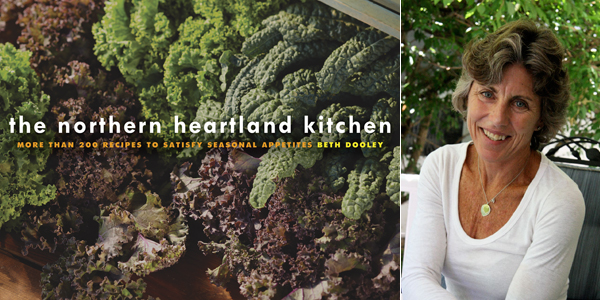
In her upcoming cookbook, The Northern Heartland Kitchen ($29.95, 280 pages, University of Minnesota Press), Twin Cities author and food critic Beth Dooley (above) sets out from where 2004’s Savoring the Seasons of the Northern Heartland left off: She refocuses her strong seasonal bent to bring home cooks more than 200 new recipes inspired not so much by the historic traditions of the Upper Midwest as by its extraordinary bounty.
In Savoring the Seasons, Dooley and Lucia Watson brought the region’s diverse native and immigrant food traditions to life, folding history, anecdotes, and photographs in with their updated recipes and creating a book that was a delightful read. Although peppered with interesting bits of advice and insight from local farmers and producers, Northern Heartland Kitchen is more of a working cookbook. Accordingly, it offers only a short introduction to the current conversation on local and sustainable food in the Upper Midwest before digging into the recipes. Two compact lists entitled “Ten good reasons to eat seasonal and local” and “What do local and regional really mean?” really pull their weight in explaining why consumers should care about and invest in local and seasonal food. Similarly, a succinct chapter on community sustainable agriculture contains good information on how to sign up for, use, and store your CSA box veggies. However, the few paragraphs in the introduction — which discuss how local producers, farmers, and researchers are using innovation, science, and sustainable practices to bring us urban gardens, longer growing seasons, and greater variety — were perhaps too brief; we turned the page wanting more of the storytelling Dooley wove into Savoring the Seasons.

Happily, what Northern Heartland Kitchen does best is provide many tasty answers to the question, What to do with all these vegetables — or as winter would have it — the lack thereof? Organized by the seasons, the book takes locavores from autumn’s cabbage, apples, and greens to winter’s hearty squash and potatoes, spring’s bright sorrel and herbs, and finally, as Dooley says, summer’s “conspiracy of ripeness.” Along the way, it makes ample use of local meat and dairy and replaces imported olive oil and other ingredients with goods produced closer to home (a resources guide at the back of the book points readers to everything from fish to foraged mushrooms, wine, and buffalo).
In cooking from the summer section, we found Dooley’s recipes fresh and inspiring, but not too precious. She wants us to cook with the seasons and spontaneously, so the recipes favor readily available and flexible ingredients — i.e., feel free to swap out that cheese for this one. This sets up a scenario in which a home cook brings home whatever looks good at the market, confident that they can pull off a meal with Dooley and whatever’s in their herb garden and pantry.
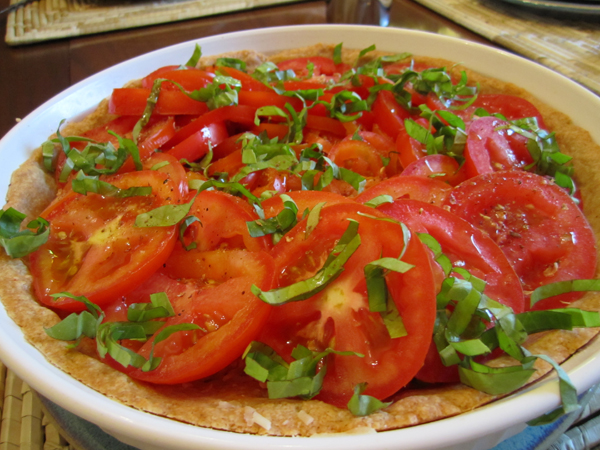
A recipe for Tomato, Tomato, and Tomato Tart is punctuated with this quote from farmer Greg Reynolds of Riverbend Farm: “Why would anyone eat tomatoes in January? They come here from China. They don’t taste good. They leave an enormous carbon footprint. They’re expensive. When the tomato crop is finished in October, I stop eating them so I can look forward to the next year’s crop in July. When I’ve been waiting for them, when I’m hungry for them, they taste best.”

Many of us have waited a few extra and very long weeks for our tomatoes to ripen this year, so it was a great pleasure to try a couple of Dooley’s tomato recipes. We heartily enjoyed the tomato tart, which featured a Parmesan cheese crust made with a small amount of wheat flour to give it a full, nutty flavor — the perfect accompaniment for the savory tang of the tomatoes and a sprinkling of basil. The tomatoes were salted, left to drain on paper towels, and then added to the tart at the last second, so there was no danger of sogginess.
The Fresh Tomato Soup with Basil Ice Cream was also a smashing success. Though spare on ingredients – essentially tomato, onion, and basil – the soup was incredibly flavorful. We tried it with cherry and heirloom tomatoes, and found that while both were good, the former yielded a sweeter, richer flavor. Lightly sweet, the basil ice cream made a delicious companion to the soup, though some were heard to complain that it would have been just as tasty swirled through the soup at room temperature and that the cook’s time would have been better spent making them grilled cheese sandwiches.
Dooley’s Traditional Basil Pesto used fewer pine nuts and cheese than some recipes. Indeed, one dining companion asked if it included pine nuts at all. However, no one seemed to miss their sweetness; tossed over egg noodles, the pesto was pungent with basil and garlic, spicy even, and very enjoyable.
A Classic Tarragon Chicken Salad combined mayo and sour cream to make a delightfully creamy picnic companion. A trio of vinegar, Dijon mustard, and red onion gave it just enough zing, and we appreciated that while it was moist enough to stand up to thick slices of sourdough bread, it did not ooze out the sides. Ladies who lunch may like it on a bed of salad, where it would take nicely to a few homegrown tomatoes.
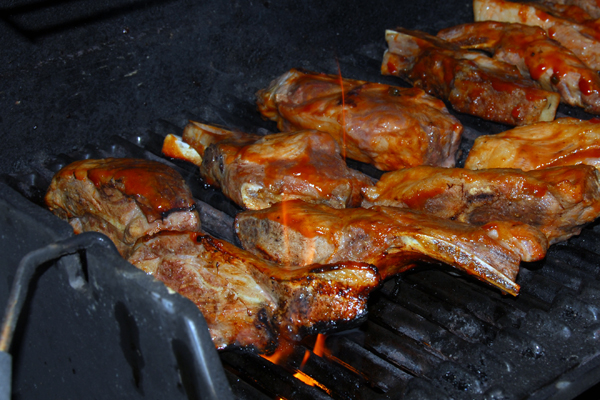
The Barbecue Ribs with Honey Jalapeno BBQ Sauce left us licking our fingers and greedy for more. The ribs are pre-cooked in a bath of beer and onions and then transferred to a grill and slathered in Dooley’s sweet-hot barbecue sauce, which mellows with cooking so that even the most sensitive palate among us found it pleasantly piquant. A keeper! (Note: Next time we go to the meat market, we will take Dooley’s advice on pork ribs. She says: The smaller the slab, the more tender the meat.)
We served it with Dooley’s Grilled Sweet Corn with Lemon Thyme Butter, which was delicious, of course. One note on this one: The recipe asked us to mash together the ingredients, but try as we might, we could not convince the lemon juice to integrate with the butter. When the lemon juice turned green with battered thyme, we tossed it all in the food processor to great success.
Also good with the ribs: Fennel Kohlrabi Slaw. Paired with a lemony vinaigrette, the salad’s bright flavors and crisp texture were a perfect foil for the rich sweetness of the ribs. A fellow diner commented that she had forgotten, over the seasons, how much she enjoyed the mild, sweet apple quality of kohlrabi. We did note that the recipe asked cooks to “thinly slice” the vegetables. It’s a small thing, but an inexperienced cook, following the directions, might simply slice the veggies and then regret that their delicious salad was not, well, very attractive. A little more guidance and these vegetables might be cut into nice little matchsticks.
There were other places in Northern Heartland Kitchen where the directions felt a bit vague; however, we were working from an advance copy of the book; these issues, small as they are, may have been addressed in a later proof. Or the author may have been attempting to keep the recipes from getting too fussy.
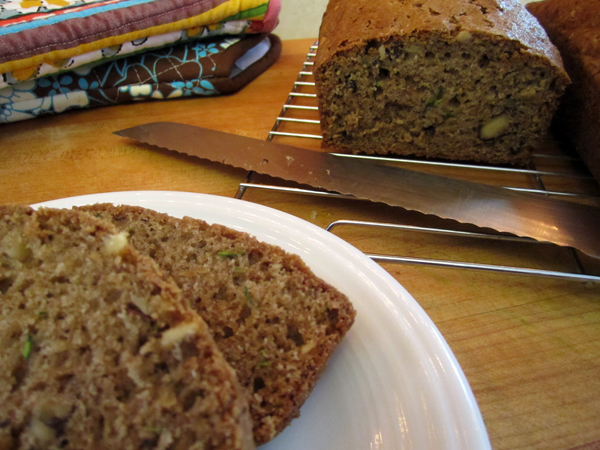
There were only two recipes that were not wholehearted successes. The dining companions were divided on the Zucchini Spice Cake. Some of us enjoyed the spice — a combination of cinnamon, ginger, and allspice — and the moist texture. Others thought there wasn’t enough zucchini; they tasted vegetable oil and baking soda. The latter comment led us to wonder if there was too much baking soda, though it did give the bread a lovely color. In any case, all of the bread was consumed.
To create the Spiced Beet Caviar, we put the raw beets, spices, and herbs in a tinfoil pouch and roasted them. It filled our kitchen with heavenly smells of roasting rosemary, cloves. and garlic. Then we chopped it all up and tossed it with raspberry vinegar and orange zest — all the right flavors, but it was simply too much vinegar and it curled our tongues. Next time, we’ll go easy on the vinaigrette and maybe pair it with goat cheese.
One recipe elicited a small gasp of appreciation from our dining companions, a Zucchini, Summer Squash, and Lemon Salad. The salad is composed of the raw vegetables — sliced thinly as to resemble noodles — a simple lemon vinaigrette, and fresh summer savory. The comments ran from “I’m not a fan of zucchini and I really like this,” to “It would never have occurred to me to eat a zucchini raw, but I like it even better.”
The Northern Heartland Kitchen publishes in October. In the meantime, you can put your zucchini (or your neighbor’s) to work in this refreshing salad.
Zucchini, Summer Squash, and Lemon Salad
Serves 4
2 zucchini
2 yellow summer squash
Grated zest and juice of 1 lemon
2 tbsp olive oil
2 tbsp chopped savory
Pinch of sugar
Salt and freshly ground black pepper
Using a potato peeler, cut the zucchini and yellow squash very thin lengthwise, and put the slices in a shallow dish. Sprinkle the grated lemon zest over them.
In a small bowl, whisk together the lemon juice, olive oil, savory, sugar, salt and pepper. Pour the dressing over the zucchini and yellow squash and toss gently.
From The Northern Heartland Kitchen by Beth Dooley (University of Minnesota Press, 2011)
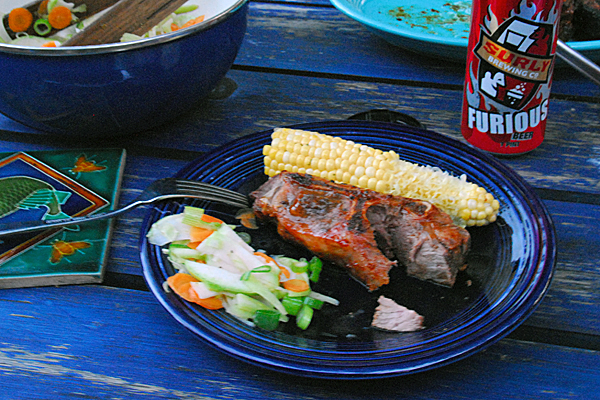

Comments are closed.